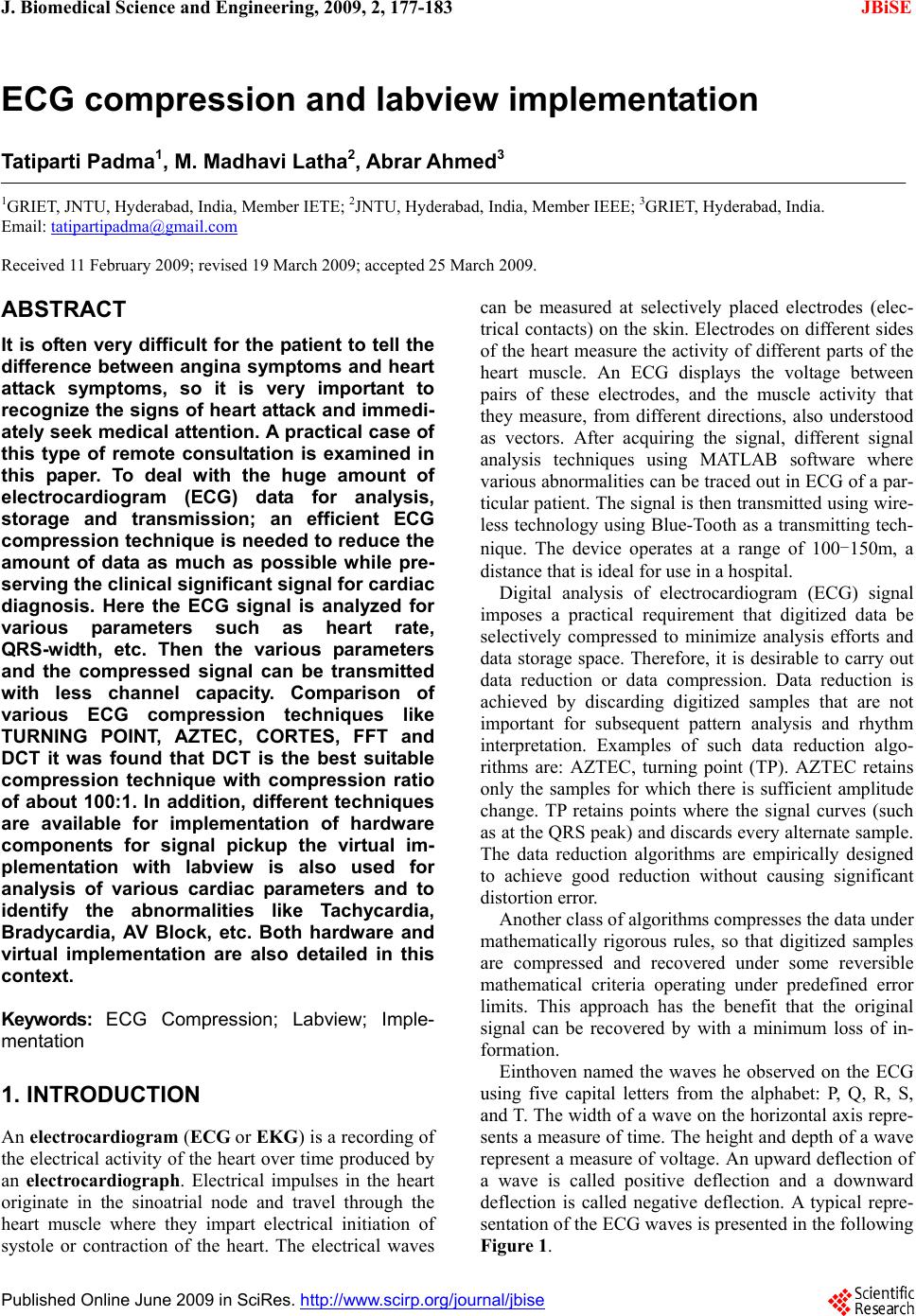
J. Biomedical Science and Engineering, 2009, 2, 177-183
Published Online June 2009 in SciRes. http://www.scirp.org/journal/jbise
JBiSE
ECG compression and labview implementation
Tatiparti Padma1, M. Madhavi Latha2, Abrar Ahmed3
1GRIET, JNTU, Hyderabad, India, Member IETE; 2JNTU, Hyderabad, India, Member IEEE; 3GRIET, Hyderabad, India.
Email: tatipartipadma@gmail.com
Received 11 February 2009; revised 19 March 2009; accepted 25 March 2009.
ABSTRACT
It is often very difficult for the patient to tell the
difference between angina symptoms and heart
attack symptoms, so it is very important to
recognize the signs of heart attack and immedi-
ately seek medical attention. A practical case of
this type of remote consultation is examined in
this paper. To deal with the huge amount of
electrocardiogram (ECG) data for analysis,
storage and transmission; an efficient ECG
compression technique is needed to reduce the
amount of data as much as possible while pre-
serving the clinical significant signal for cardiac
diagnosis. Here the ECG signal is analyzed for
various parameters such as heart rate,
QRS-width, etc. Then the various parameters
and the compressed signal can be transmitted
with less channel capacity. Comparison of
various ECG compression techniques like
TURNING POINT, AZTEC, CORTES, FFT and
DCT it was found that DCT is the best suitable
compression technique with compression ratio
of about 100:1. In addition, different techniques
are available for implementation of hardware
components for signal pickup the virtual im-
plementation with labview is also used for
analysis of various cardiac parameters and to
identify the abnormalities like Tachycardia,
Bradycardia, AV Block, etc. Both hardware and
virtual implementation are also detailed in this
context.
Keywords: ECG Compression; Labview; Imple-
mentation
1. INTRODUCTION
An electrocardiogram (ECG or EKG) is a recording of
the electrical activity of the heart over time produced by
an electrocardiograph. Electrical impulses in the heart
originate in the sinoatrial node and travel through the
heart muscle where they impart electrical initiation of
systole or contraction of the heart. The electrical waves
can be measured at selectively placed electrodes (elec-
trical contacts) on the skin. Electrodes on different sides
of the heart measure the activity of different parts of the
heart muscle. An ECG displays the voltage between
pairs of these electrodes, and the muscle activity that
they measure, from different directions, also understood
as vectors. After acquiring the signal, different signal
analysis techniques using MATLAB software where
various abnormalities can be traced out in ECG of a par-
ticular patient. The signal is then transmitted using wire-
less technology using Blue-Tooth as a transmitting tech-
nique. The device operates at a range of 100-150m, a
distance that is ideal for use in a hospital.
Digital analysis of electrocardiogram (ECG) signal
imposes a practical requirement that digitized data be
selectively compressed to minimize analysis efforts and
data storage space. Therefore, it is desirable to carry out
data reduction or data compression. Data reduction is
achieved by discarding digitized samples that are not
important for subsequent pattern analysis and rhythm
interpretation. Examples of such data reduction algo-
rithms are: AZTEC, turning point (TP). AZTEC retains
only the samples for which there is sufficient amplitude
change. TP retains points where the signal curves (such
as at the QRS peak) and discards every alternate sample.
The data reduction algorithms are empirically designed
to achieve good reduction without causing significant
distortion error.
Another class of algorithms compresses the data under
mathematically rigorous rules, so that digitized samples
are compressed and recovered under some reversible
mathematical criteria operating under predefined error
limits. This approach has the benefit that the original
signal can be recovered by with a minimum loss of in-
formation.
Einthoven named the waves he observed on the ECG
using five capital letters from the alphabet: P, Q, R, S,
and T. The width of a wave on the horizontal axis repre-
sents a measure of time. The height and depth of a wave
represent a measure of voltage. An upward deflection of
a wave is called positive deflection and a downward
deflection is called negative deflection. A typical repre-
sentation of the ECG waves is presented in the following
Figure 1.